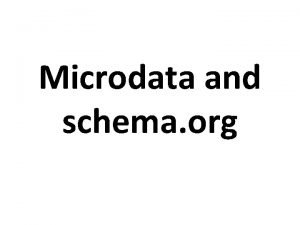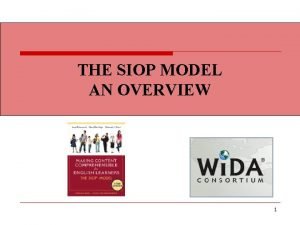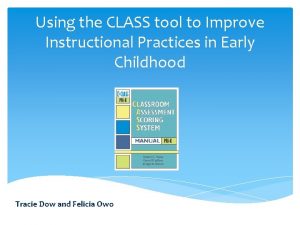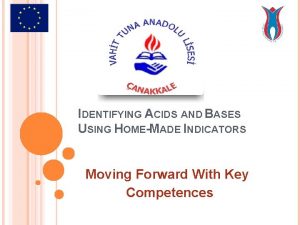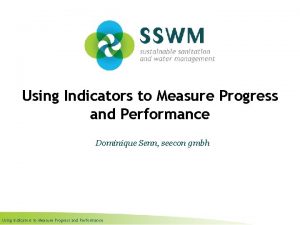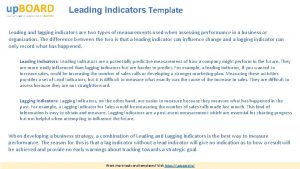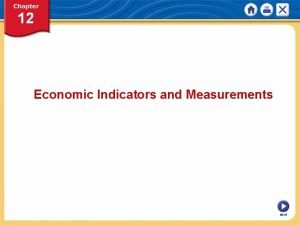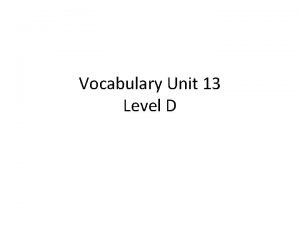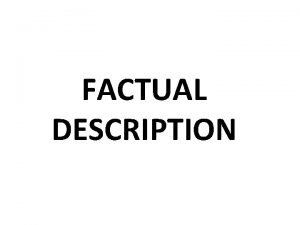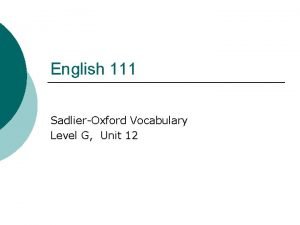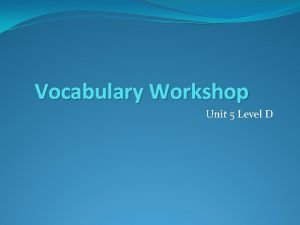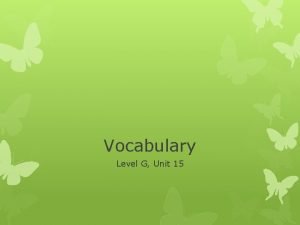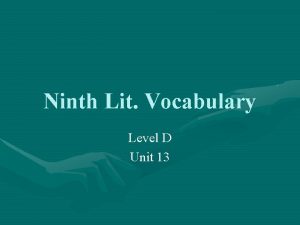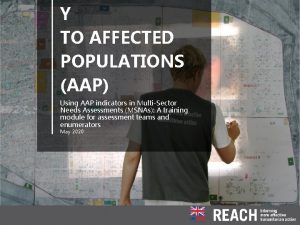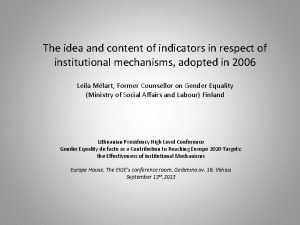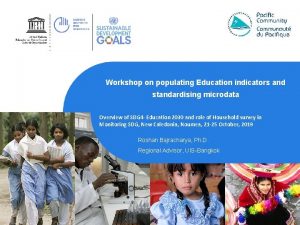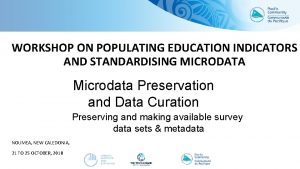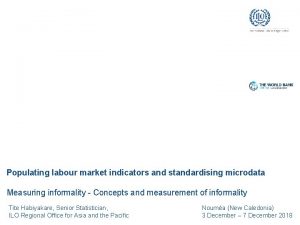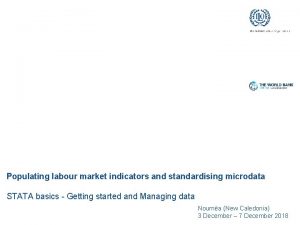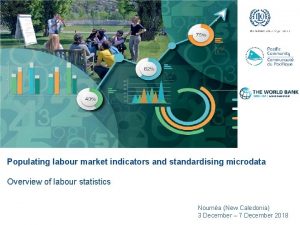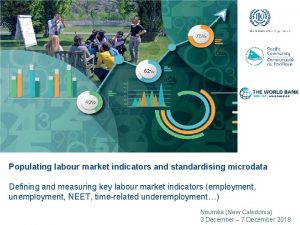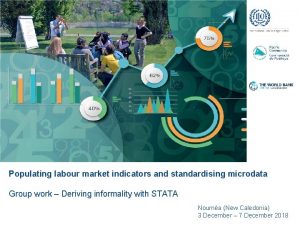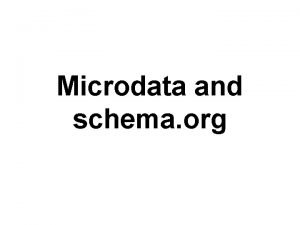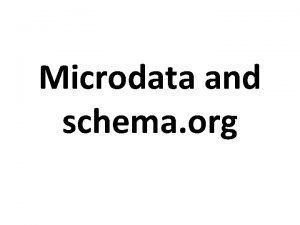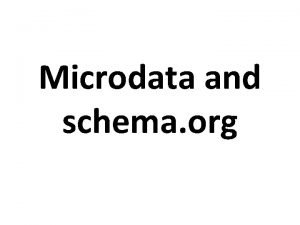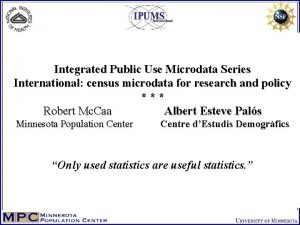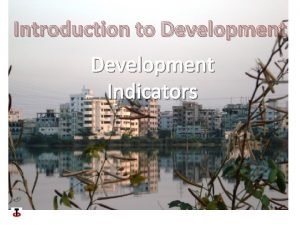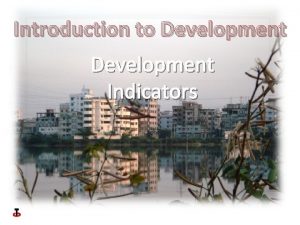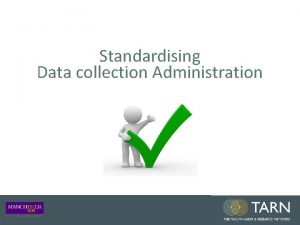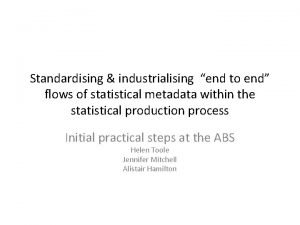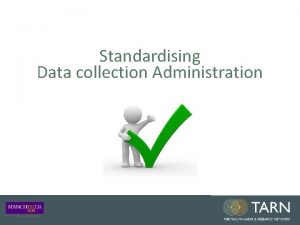Workshop on populating Education indicators and standardising microdata




![The 10 Targets Outcome Targets [7] 4. 1 Quality primary/secondary education for all Means The 10 Targets Outcome Targets [7] 4. 1 Quality primary/secondary education for all Means](https://slidetodoc.com/presentation_image_h/19323fe7b1307997cef600f2ed8ac5e5/image-5.jpg)























- Slides: 28

Workshop on populating Education indicators and standardising microdata Overview of SDG 4 - Education 2030 and role of Household survey in Monitoring SDG, New Caledonia, Noumea, 21 -25 October, 2019 Roshan Bajracharya, Ph. D. Regional Advisor, UIS-Bangkok

Contents • Overview of SDG 4 - Goal and Targets • Global and Thematic Monitoring and Indicators Frameworks • SDG 4 Monitoring and Household Surveys

Sustainable Development Goal (SDG) 4 “Ensure inclusive and equitable quality education and promote lifelong learning opportunities for all” • • Universal relevance - both global North and global South Rights-based and a public good Inclusion, equity and gender equality as fundamental principles Addresses all forms of discrimination and of situations, including emergencies, which impede the fulfilment of the right to education. “No one left behind”

Global Education Agendas compared MDG 2 EFA SDG 4 Scope Primary Education (children) Basic Education (children, youth & adults) Basic education + Post-basic education with Lifelong perspective Coverage Low-income countries; Conflict-affected Universal in intention; Focus on lowerincome countries Universal agenda Global North and South Process led by UN UN Member States Policy focus Access to and completion of primary education for all Access to quality basic learning for all + Equitable access to postbasic education + Relevance of learning for work & citizenship No of targets 2 6 goals 10
![The 10 Targets Outcome Targets 7 4 1 Quality primarysecondary education for all Means The 10 Targets Outcome Targets [7] 4. 1 Quality primary/secondary education for all Means](https://slidetodoc.com/presentation_image_h/19323fe7b1307997cef600f2ed8ac5e5/image-5.jpg)
The 10 Targets Outcome Targets [7] 4. 1 Quality primary/secondary education for all Means of implementation [3] 4. 2 Early childhood & pre-primary education 4. a Safe & inclusive learning environments 4. 3 Equal access to TVET & higher education 4. b Scholarships for higher education 4. 4 Relevant skills for work 4. c Teachers’ training and working conditions 4. 5 Gender equality & equal access for all 4. 6 Youth and adult literacy 4. 7 Global citizenship education for sustainability

• Integrates the ‘unfinished EFA agenda’ in the SDGs through • Global targets (4. 1, 4. 2, 4. 5 and 4. 6) - same for all countries • Global ‘signposts’ (4. 3, 4. 4, 4. 7, 4. a and 4. c) – no global quantitative targets for all countries to reach • to be contextualized in national education policy priorities • require the setting of quantifiable benchmarks at national lev

Education targets/indicators in other SDGs : 1, 3, 5, 8 No Poverty Global indicator: Proportion of total government spending on essential services (education, health and social protection) Health and Well-being Target 3. 7: By 2030, ensure universal access to sexual and reproductive health-care services, including for family planning, information and education, and the integration of reproductive health into national strategies and programmes Gender Equality Global Indicator: Number of countries with laws and regulations that guarantee women aged 15 -49 years access to sexual and reproductive health care, information and education Decent Work and Economic Growth Target 8. 6: By 2020 substantially reduce the proportion of youth not in employment, education or training

Education targets/indicators within other SDGs - 12, 13, 16 Responsible Consumption & Production Target 12. 8: By 2030 ensure that people everywhere have the relevant information and awareness for sustainable development and lifestyles in harmony with nature Climate Change Mitigation Target 13. 3: Improve education, awareness raising and human and institutional capacity on climate change mitigation, adaptation, impact reduction, and early warning Peace, Justice and Strong Institutions Global indicator: Primary government expenditures as a proportion of original approved budget by sector (or by budget codes or similar)

SDG indicators intersecting 1 4 5 x x x x 4. 3 x x x 4. 4 x x x 4. 5 x x 4. 6 x x 4. 1 x 4. 2 x 3 x 7 x x 8 9 10 x x 4. 7 x 4. a x x x 4. b x x x x x 4. c x 6 x x x 11 x x 12 13 14 15 16 17 x x x x

Monitoring of SDG 4 and Indicators Frameworks

Three key data priorities for Education 2030 • Broad scope across the life cycle: Indicators for areas which are on the “margins” of the formal education system, but recognized as critically important to achieving the development goals (levels and types) • Education quality: results of learning at all stages of education provision or learning opportunities • Equity: measures that capture those who are excluded from education provision or learning opportunities

Monitoring Frameworks for SDG 4 • • SDG 4 consists of 7+3 targets and 43 indicators. There are 4 monitoring levels. The 11 global indicators are led by IAEG-SDGs. TCG SDG 4 -ED 2030 leads the methodological development and implementation of the 43 thematic indicators. Focused set of globally comparable indicators based on clear criteria (11 indicators) Thematic National Links to national plan; consult national stakeholders; recognise context and addresses inclusion and broader learning goals Broader set of indicators that covers the range of sectoral priorities (43 indicators, including 11 global indicators) Global Regional Indicators which make up monitoring frameworks validated by regional bodies Source: UIS, 2016 based on UNSG, 2014

Thematic Indicator Framework A set of 43 indicators produced on an internationally-comparable basis • Framework to follow-up of progress at the global level. To track progress on the SDG 4 with wider view – Education 2030 Agenda It includes the 11 indicators proposed by the IAEG-SDGs for tracking SDG 4 • 11 global indicators • 32+ additional indicators A reference for regional reviews and national monitoring Developed by the Technical Advisory Group (TAG) in the context of discussions on new education agenda to: • Should serve as a “Menu” to respond to regional and national priorities • Provide recommendations for education indicators • Help guide the establishment of a measurement agenda

Areas of Monitoring and Data Sources Inequity (parity) Areas of Monitoring Policies and provision Access and participation Completion Skills Learning outcomes Teacher quality School environment & resources Possible Sources of data at national level Policy documents/Legislations Administrative/Household surveys Administrative data/Household surveys Examinations/Periodic assessments Administrative data Administrative records • Diverse monitoring areas; from policies to learning outcomes and skills of children to skills of adults. • One single source of data will not be able to monitor all indicators. • Need for strong collaboration in identifying the different data sources and their strengths.

UIS as the main custodian agency for SDG 4 data

SDG 4 Monitoring and Household Survey Data

Domains of International Education Statistics & Sources Domains of education statistics q Administrative data and planning (UIS) - Enrolment, Teacher, Expenditure, resources q Student assessment & surveys - Testing: Achievement (mathematics, reading), classroom processes, enabling conditions - Household surveys: family background q Literacy & Educational attainment (UIS) - Census data, household survey data Administrative data sources -UIS core data collection Annual data National aggregates Input-oriented Cross-nationally comparable Also collect/use a range of other data sources Direct assessment: Literacy Assessment and Monitoring Programme (LAMP) School-based surveys: World Education Indicators (WEI) Survey of Primary Schools Household surveys: Out-of-school children and data quality Policy frameworks: Teachers’ working conditions

Different data collection methods 1. Administrative data collection • Regular (School census, reporting) • Ad-hoc 2. School inspection 3. Sample surveys 4. Population censuses 5. Research and case studies

Exercise on sources of data for Indicators

Key International Household Surveys • Multiple Indicator Cluster Survey • Demographic and Health Survey • Living Standard Measurement Study • Labour Force Survey • Household Income and Expenditure Survey

Education data in Household Surveys and Censuses • Geographic context • Household characteristic ( wealth, size, no. of children • Member Characteristics (Age, sex, employment, education, literacy) • schooling status of children

Education data in Household Surveys and Censuses Indicator Literacy/illiteracy rate Possible disaggregation Age, sex, wealth, location, disability, ethnicity migration status etc. Example questions Can the person read and write with an understanding of [NATIONAL] language? Can the person read and write with an understanding of another language? [INDICATE LANGUAGE] Source: General Population Census of the Kingdom of Cambodia 2008 Can [NAME] read letters/books/newspaper? Source: Bangladesh Education Household Survey 2014 As a regular part of this work, do you (did you) have to read the following [CHOOSE ITEM]? (bills, payments, newspapers, forms, other) Source: STEP Educational attainment/ Generally those age 15 and older Age, sex, wealth, location, disability, ethnicity, mother tongue/(s) and migration status; What is the highest level and grade or year of school [NAME] has ever attended? Source: MICS 6 for Household 6 What grade or year is [NAME] currently attending? Source: Household Profile Questionnaire Philippines 2012 Completion rate What is the level of education currently attended? (for person in question) Source: Brunei Darussalam Labour Force Survey 2017 What is the highest qualification [NAME] obtained? Source: Vietnam Household Registration System Survey 2015

Education data in Household Surveys and Censuses Indicator Possible disaggregation Example questions Gross intake rate (GIR) Net intake rate (NIR) Gross enrolment rate (GER) Net enrolment rate (NER) Age-specific attendance ratio (ASAR) Age, sex, wealth, location, disability, ethnicity, mother tongue/first language, second/other language(s) and migration status Did [NAME] attend school at any time during the [PREVIOUS] school year? Transition rate Promotion rate Repetition rate Dropout rate Survival rate Age, sex, wealth, location, disability, ethnicity, mother tongue/first language, second/other language(s) and migration status Did [NAME] attend school at any time during the [PREVIOUS] school year? During [CURRENT] school year, what level and grade [is/was] [NAME] attending? Source: DHS Cambodia 2014. What is the highest level and grade or year of school [NAME] has ever attended? During that previous school year, which level and grade or year did [NAME] attend? During this current school year, which level and grade or year is [NAME] attending? Source: MICS 6 for Household

Education data in Household Surveys and Censuses Indicator Out-of-school population Possible disaggregation Age, sex, wealth, location, disability, ethnicity, mother tongue/first language and migration status Example questions Did (NAME) ever-attending school? What is the highest grade /level of education attended? Did [NAME] attend school at any time during the [PREVIOUS] school year? During [CURRENT] school year, what level and grade [is/was] [NAME] attending? Source: DHS Cambodia 2014 What is the highest level and grade or year of school [NAME] has ever attended? During that previous school year, which level and grade or year did [NAME] attend? During this current school year, which level and grade or year is [NAME] attending? Source: MICS 6 for Household 6 Over-age /Under-age Age, sex, wealth, location, disability, ethnicity, mother tongue/first language, second/other language(s) and migration status Education expenditure Age, sex, wealth, location, disability, ethnicity, mother tongue/first language At which level of education is [NAME]? Which grade is [NAME] attending? Source: Vietnam Household Registration System Survey 2015 In last 12 months, how much money was spent for each studying member of the household? (by item, such as books, paper, tuition fees, uniforms, examination fee, internet, etc. ) Source: Bangladesh Education Household Survey 2014 What are the expenditures on [NAME]'s education over the past 12 months for compulsory subjects in school? (open question) How much do you have to pay to enrol [NAME] in school?

Education data: Administrative vs Household Surveys and Censuses Administrative Surveys • • Schools and other educational institutions regularly report data on students, teachers, expenditures, and physical facilities • To gauge the capacity and performance of schools in relation to national education goals and plans, • To determine future development policies, plans and management arrangements. Like other administrative data collection (such as health and social welfare), collected data face shortcomings related to data quality • Coverage • In many countries, administrative data are only available for schools in the formal government sector or for private schools that receive significant government funding • Accuracy • Non-reporting schools have been estimated • Timeliness • Rarely available for a next school year for planning Data typically provides limited information on the individual characteristics of pupils Almost no information on the characteristics of • • • Provide important education data that can be analysed according to household and individual characteristics The availability of multiple censuses and surveys conducted over time enables changes to be tracked within a given timeframe, assuming consistency in survey questions and methodology Provide information on aspects of children’s background that may influence household schooling decisions Children’s school enrollment or school attendance can be analysed according to household and child characteristics • Family wealth • Social characteristics • Child characteristics (disability, birth order, etc. . ) Educational attainment and literacy skills Most of the major household surveys are nationally representative

Issues and challenges with education indicators from household surveys • Due to the design of the survey, their frequencies, sampling techniques used and sample size, and timing of the survey, some issues and challenges in using household survey for education monitoring might come up; 1. There a lack of coordination with the Ministry of Education and National Statistics Office 2. The usefulness of census data is more reviewing historic trends than studying the current situation 3. The phrasing of questions and definition regarding school enrolment and attendance influences measuring educational participation 4. The survey timing and duration of survey fieldwork influences the recentness of collected

Issues and challenges with education indicators from household surveys 5. The survey dates rarely coincide with the 6. 7. 8. 9. beginning of the school year, which can lead to discrepancies between a household survey and an administrative source The representativeness of sample depends on the survey design such as the sampling method used, the level of accuracy and the level of data disaggregation There a lack of awareness about the existence and accessibility of household survey data Little information about education is presented in main reports of household surveys Little presented information usually goes together with a lack of knowledge on and skills to analyze education data from household surveys to support evidence

Data to transform lives Roshan Bajracharya, UIS-Bangkok r. bajracharya@unesco. org Learn more http: //uis. unesco. org/ @UNESCOstat #Fund. Data
 Schema.org microdata
Schema.org microdata Public use microdata sample
Public use microdata sample Northwind data warehouse
Northwind data warehouse Siop and tap have similar descriptors and indicators
Siop and tap have similar descriptors and indicators Formal and non formal education venn diagram
Formal and non formal education venn diagram Differences between health promotion and health education
Differences between health promotion and health education Class domains dimensions and indicators
Class domains dimensions and indicators Homemade indicators for acids and bases
Homemade indicators for acids and bases Sports and entertainment marketing performance indicators
Sports and entertainment marketing performance indicators What are “cream” and “spiced” indicators
What are “cream” and “spiced” indicators Identify three effects of low humidity s190
Identify three effects of low humidity s190 Leading and lagging indicators powerpoint template
Leading and lagging indicators powerpoint template Chapter 12 economic indicators and measurements
Chapter 12 economic indicators and measurements Backbone of extension education
Backbone of extension education Unit 6 level d antonyms
Unit 6 level d antonyms Vocabulary workshop level g unit 13
Vocabulary workshop level g unit 13 A factual description
A factual description Vocabulary workshop level g unit 1
Vocabulary workshop level g unit 1 Vocabulary level d unit 5
Vocabulary level d unit 5 Level f unit 8 synonyms
Level f unit 8 synonyms Monty's noodles montmorency
Monty's noodles montmorency Pros and cons of reading workshop
Pros and cons of reading workshop Workshop health and safety poster
Workshop health and safety poster Level g unit 15 vocab
Level g unit 15 vocab Synonym
Synonym Aap indicators
Aap indicators Indicators of potential workplace violence
Indicators of potential workplace violence Theory of indicators
Theory of indicators Respect indicators
Respect indicators
